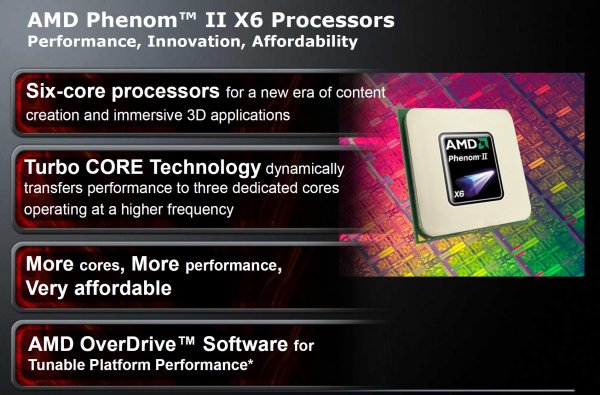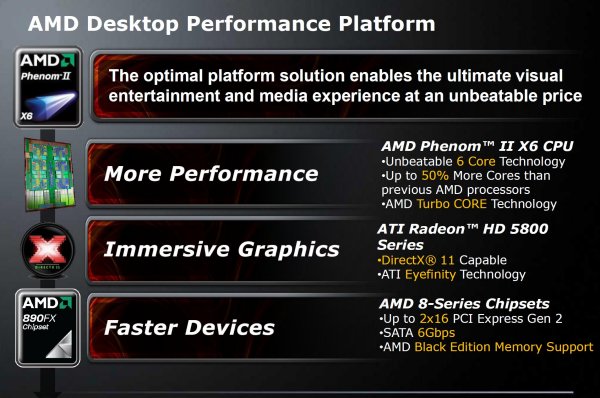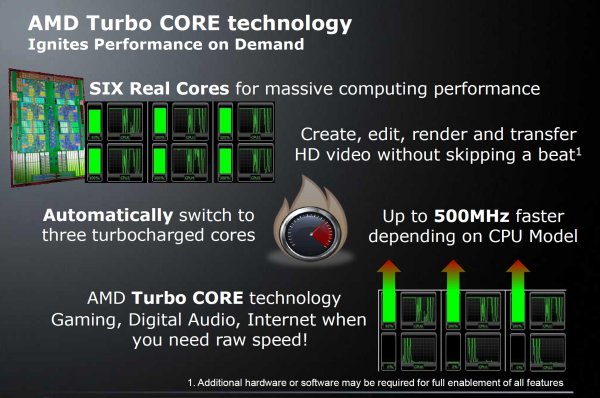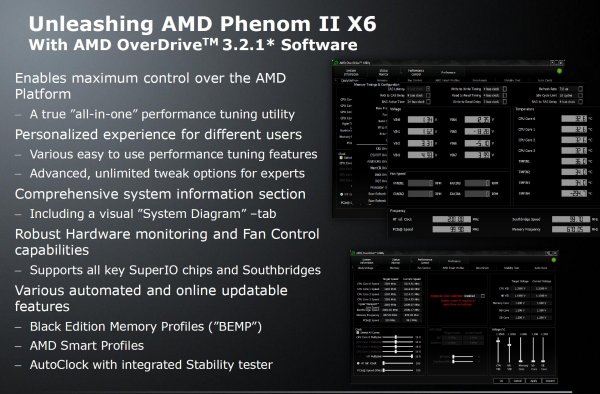All New Thuban and Zosma Lines for 2010
Although today AMD is announcing just two new processors, rumor has it we can expect a few more new models in the coming months. The Phenom II X6 1090T BE and 1055T processors are based on the architecture codenamed "Thuban" that uses the 45nm design process.

Also slated for release are the Phenom II X6 1035T and 1075T processors that will operate at 2.6GHz and 3.0GHz, respectively. Meanwhile today's release comprises of the Phenom II X6 1090T BE and 1055T processors that work at 3.2GHz and 2.8GHz.
All the Thuban processors feature the traditional Phenom II 6MB L3 cache, while each individual core receives its own 512KB L2 cache. Compared to the Phenom II X4 processors that boast a total cache of 8MBs, the newer X6 models carry a total of 9MBs.

Unlike the much more expensive Core i7 980X, AMD's six-core processors have not made the move to 32nm, as mentioned earlier they are still 45nm parts. Despite this AMD has specified a moderate TDP rating of 125 watts, even when operating at 3.2GHz.
The Phenom II X6 processors support all the same features as the previous Phenom II X4 models with the addition of one new feature called Turbo Core. This hardware-based C-state performance boost technology is AMD's equivalent of Intel Turbo Boost. Intel's Turbo Boost technology can increase the operating frequency of the Core i7 980X from the default 3.33GHz to 3.60GHz if just one or two cores of the six available are in use.

The AMD Turbo Core technology works a little differently. Turbo Core can automatically increase the frequency of three active cores by up to 500MHz without the need for any special software or drivers. The technology works by putting three cores into a boost-enabled P-state when power consumption is below the processor's rated TDP.
Being in the boost-enabled P-state doesn't mean the three cores are instantly overclocked by 500MHz. Instead they are ready to have their frequencies increased based on the processing workload.
The Turbo Core feature works in conjunction with AMD Cool 'n' Quiet. A processor like the Phenom II X6 1090T could be working at anywhere between the minimum operating frequency and the maximum, not necessarily the Turbo Core maximum. Interestingly, AMD specifies that the Turbo Core boosted cores do not necessarily have to be operating at the same frequency either.

The Phenom II X6 1090T BE has a maximum Turbo Core speed of 3.6GHz, 400MHz above its default operating frequency. The Phenom II X6 1055T can go from 2.8GHz up to 3.3GHz which is a healthy 500MHz boost.
Finally, we would like to take a moment to talk about the upcoming Phenom II X4 960T processor, which is based on the Zosma 45nm quad-core architecture. The key difference between Zosma and the current 'Deneb' Phenom II X4 processors is that Zosma mirrors Thuban features but disables two cores.
In other words, the Phenom II X4 960T will receive Turbo Core support and perhaps more importantly will have six cores at heart. Like the Phenom II X2 and X3 processors which can more often than not be turned into real quad-cores, motherboard manufacturers are already working to help users turn the upcoming X4 960T processor into a Phenom II X6 minus the added expense.
Although there is nothing entirely solid about this upcoming Phenom, given AMD's current pricing strategy we believe it will become available at less than $200. Just imagine the potential down the line...
